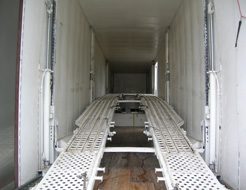(a) Dimensions — (1) Size. A sleeper berth must be at least the following size:
§393.76 Sleeper berths.
1In the case of a sleeper berth which utilizes an adjustable mechanical suspension system, the required clearance can be measured when the suspension system is adjusted to the height to which it would settle when occupied by a driver.
(a)(2) Shape. A sleeper berth installed on a motor vehicle on or after January 1, 1953 must be of generally rectangular shape, except that the horizontal corners and the roof corners may be rounded to radii not exceeding 10 12 inches.
(a)(3) Access. A sleeper berth must be constructed so that an occupant’s ready entrance to, and exit from, the sleeper berth is not unduly hindered.
(b) Location. (1) A sleeper berth must not be installed in or on a semitrailer or a full trailer other than a house trailer.
(b)(2) A sleeper berth located within the cargo space of a motor vehicle must be securely compartmentalized from the remainder of the cargo space. A sleeper berth installed on or after January 1, 1953 must be located in the cab or immediately adjacent to the cab and must be securely fixed with relation to the cab.
(c) Exit from the berth. (1) Except as provided in paragraph (c)(2) of this section, there must be a direct and ready means of exit from a sleeper berth into the driver’s seat or compartment. If the sleeper berth was installed on or after January 1, 1963, the exit must be a doorway or opening at least 18 inches high and 36 inches wide. If the sleeper berth was installed before January 1, 1963, the exit must have sufficient area to contain an ellipse having a major axis of 24 inches and a minor axis of 16 inches.
(c)(2) A sleeper berth installed before January 1, 1953 must either:
(c)(2)(i) Conform to the requirements of paragraph (c)(1) of this section; or
(c)(2)(ii) Have at least two exits, each of which is at least 18 inches high and 21 inches wide, located at opposite ends of the vehicle and useable by the occupant without the assistance of any other person.
(d) Communication with the driver. A sleeper berth which is not located within the driver’s compartment and has no direct entrance into the driver’s compartment must be equipped with a means of communication between the occupant and the driver. The means of communication may consist of a telephone, speaker tube, buzzer, pull cord, or other mechanical or electrical device.
(e) Equipment. A sleeper berth must be properly equipped for sleeping. Its equipment must include:
(e)(1) Adequate bedclothing and blankets; and
(e)(2) Either:
(e)(2)(i) Springs and a mattress; or
(e)(2)(ii) An innerspring mattress; or
(e)(2)(iii) A cellular rubber or flexible foam mattress at least four inches thick; or
(e)(2)(iv) A mattress filled with a fluid and of sufficient thickness when filled to prevent “bottoming out” when occupied while the vehicle is in motion.
(f) Ventilation. A sleeper berth must have louvers or other means of providing adequate ventilation. A sleeper berth must be reasonably tight against dust and rain.
(g) Protection against exhaust and fuel leaks and exhaust heat. A sleeper berth must be located so that leaks in the vehicle’s exhaust system or fuel system do not permit fuel, fuel system gases, or exhaust gases to enter the sleeper berth. A sleeper berth must be located so that it will not be overheated or damaged by reason of its proximity to the vehicle’s exhaust system.
(h) Occupant restraint. A motor vehicle manufactured on or after July 1, 1971, and equipped with a sleeper berth must be equipped with a means of preventing ejection of the occupant of the sleeper berth during deceleration of the vehicle. The restraint system must be designed, installed, and maintained to withstand a minimum total force of 6,000 pounds applied toward the front of the vehicle and parallel to the longitudinal axis of the vehicle.
[39 FR 14711, Apr. 26, 1974; 39 FR 17233, May 14, 1974, as amended at 53 FR 49401, Dec. 7, 1988].



